Home | Category: Commercial and Sport Fishing and Fish
SALMON FARMING
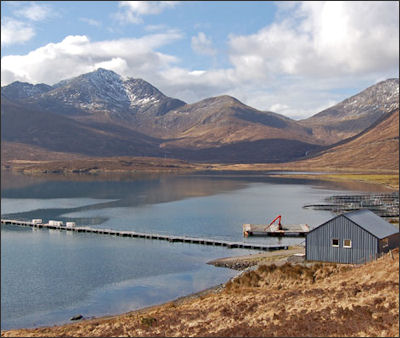
Cairidh Salmon Farm jetty in Scotland About 70 percent of the salmon people eat at restaurants and buy in supermarkets is raised in fish farms. In 2021, more than 2.8 million tons of farmed salmonids were produced. In comparison, only around 705,000 tons of wild salmonids were caught. [Source: Statista]
Salmon farming began as a cottage industry in Norway in the late 1960s and spread to the U.K. and Canada in the 1970s, to the United States (Maine) in the later 1970s and to Chile in the 1990s. Before 1980, there not many salmon farms. Helped by increased demand from the United States and Japan, the industry grew enormously in the 1990s. As of the early 2000s, it was a $2 billion-a year business that produces 2.6 million pounds of fish of year.
Atlantic salmon have been raised in hatcheries since 1864 to enhance wild populations. Today, these hatcheries help to prevent further decline of Atlantic salmon and subsequently prevent their extinction. As of the late 2000s, many of the farms were controlled by six large multinational corporations, three of them based in Norway. They have managed to not only make handsome profits meeting the demand of health-conscious fish eaters but they have done so by causing salmon prices to drop so low fish caught by commercial fishing can not compete. Fish farms have made salmon available throughout the year in much of the world. Every night jets loaded with salmon leave airports in Norway, Scotland and Chile bound for Japan and the United States.
Salmon farming reduces the pressure on wild stocks but creates some environmental problems. Fish-farmed salmon is said to have a fishier taste and is less easy to digest than wild salmon. It is also fattier but contains less health-improving omega-3 fatty acids.
Much of farm-raised salmon eaten in the United States comes from Chile. In the 2000s it t cost $4 or $5 a pound compared to $15 a pound for wild salmon. Salmon production in 2001(metric tons); 1) Norway (436,736); 2) Chile (262,840); 3) United Kingdom, mostly Scotland (128,959); 4) Canada (78,945); 5) Faroe Islands (28,292); 6) United States (22,395). There are also salmon farms in Ireland and Iceland.
See Separate Articles: AQUACULTURE AND FISH FARMS ioa.factsanddetails.com; SALMON: CHARACTERISTICS, MIGRATIONS, HUMAN FOOD, DECLINES ioa.factsanddetails.com ; ATLANTIC SALMON: CHARACTERISTICS, MIGRATIONS AND COLLAPSE ioa.factsanddetails.com; SALMON SPECIES ioa.factsanddetails.com
Websites and Resources: Animal Diversity Web (ADW) animaldiversity.org; National Oceanic and Atmospheric Administration (NOAA) noaa.gov; Fishbase fishbase.se ; Encyclopedia of Life eol.org ; Smithsonian Oceans Portal ocean.si.edu/ocean-life-ecosystems
Atlantic Salmon — the Main Farmed Salmon Species

Loch Ainort fish farm in Scotland There are four types of salmon raised in fish farms: 1) Atlantic salmon (Salmo salar); 2) coho salmon (Oncorhynchus kisutch); and 3) chinook salmon (Oncorhynchus tshawytscha). Atlantic salmon accounts for about 90 percent of the farmed salmon sold today. As of 2003, of the world’s roughly 300 million adult Atlantic salmon, only 3.5 million were wild. Most farmed salmon are raised in bays and inland seas, where the water is relatively calm and protected and pen-damaging waves are largely absent.
Atlantic salmon (Salmo salar) is the most common farmed salmon. It makes up the biggest saltwater farmed fish industry by species and the 8th biggest farmed fish industry by species. A total of 2,066,561 tonnes (1000 kilograms) of Atlantic salmon was harvested in 2021. The wild Atlantic salmon fishery is commercially dead; after extensive habitat damage and overfishing, wild fish make up only 0.5 percent of the Atlantic salmon available in world fish markets. The rest are farmed, predominantly from aquaculture in Norway, Chile, Canada, the UK, Ireland, Faroe Islands, Russia and Tasmania in Australia.
Atlantic salmon are spawned and raised in on-land hatcheries until large enough for transfer to net-pens in coastal waters. Farmed salmon are incredibly efficient at converting feed to edible protein. Alternative feeds have been developed to reduce the amount of fish meal and fish oil from forage fish. Growth rates vary, depending on season, age, sex and population density. Juvenile “smolts” grow much faster in saltwater than in freshwater.[Source: NOAA]
In the U.S., federal and state regulations and monitoring requirements ensure that salmon farming has minimal impact on the environment. Atlantic salmon are rich in omega-3 fatty acids. They are not fed or injected with dyes. Antibiotic use is strictly limited in the United States and is prescribed only on a case-by-case basis by an on-site veterinarian. [Source: NOAA]
See Separate Article: ATLANTIC SALMON: CHARACTERISTICS, MIGRATIONS AND COLLAPSE ioa.factsanddetails.com
Salmon Farms
Salmon farms have been compared to feed lots. The fish live in pens or cages that resemble then pens used by cattle at feed lots. They are fed pellets to help them grow faster and sprayed with pesticides that kill the lice that infect them. Sometime they are also given antibiotics.

Lachs farm A typical farm has 700,000 salmon kept in a dozen pens. A single pen that consist of nylon nets is set in calm water and tethered to the relatively shallow bottom with steel cables. Each pen is about 60 to 100 feet square and 100 feet deep. A single pen holds 50,000 to 90,000 fish. A large farm may have 3 million fish in pens that spread out over several hundred acres. Walkways often connect the pens. They allow workers to access the pens for feeding and checking out the fish.
In Scotland the number of farmed salmon exceed wild salmon by 300 or 400 to one. Scotland is the third largest salmon producer in the world, with approximately 10 percent of the global market share. In the early 2000s the industry employed 8,500 people and annually pumped $300 million into the economy. In Norway a single farm produces as many salmon a year as the estimated 600,000 wild salmon that migrate up the country’s 650 salmon rivers to spawn.
The salmon are fed fish oil and fish meal or pellets made from sardines or anchovies or another protein source such as soy beans or waste from meat factories. The pellets often contain natural pigments, extracted from shrimp and other prey that wild salmon eat, to give their meat the characteristic pink color. In some places synthetic dyes are used.
The salmon’s diet consists of 45 percent fish meal, 25 percent fish oil, 15 percent vegetable or cereal, 10 percent moisture, 4 percent vitamins and minerals and 1 percent blood or feather meal. The food is mostly in the form of brown pellets that are shot through pneumatic tubes from floating silos.
U.S. fish producers outsource processing to China. Pacific salmon caught in U.S. Northwest and flounder caught off Alaska are shipped to China for processing. Even though the fish make a round-trip journey of up to 12,800 kilometers it is still cheaper preparing it this way than processing it in the United States. Processing salmon, which requires removing 36 pin bones, is best done by hand. The cost in China is 20 cents per pound compared to $1 per pound in the United States.
Salmon in Salmon Farms
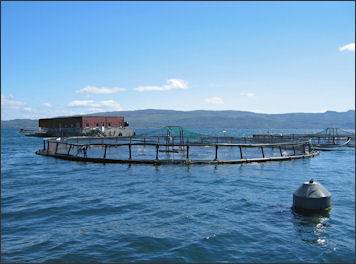
Salmon farm in Portree Bay Salmon specially-selected for rapid growth are hatched from eggs in hatcheries. The small fish are raised in fresh-water rivers and lakes and then transferred to pens in quiet bays or fjords when there are three-ounce smelts. It takes about 18 months for a smelt to mature into a 12 pound fish, ready for harvesting.
Farmed salmon grow about twice as fast as wild salmon. They spend their whole lives swimming around in circles within their pen. In many cases their fins become worn from rubbing against other fish and the nets. Their waste often accumulates not far below them in the shallow water and remains there because of the presence only weak currents.
Most fish farms, even those on the Pacific Ocean, raise Atlantic salmon. Roughly 300 million Atlantic salmon are raised in fish farms, about 70 times the number found in the wild. They are preferred over Pacific salmon because the grow fast and survive better is cramped conditions inside the pens.
Wild salmon eat large number of crustaceans. That is where they get their pink color. Farmed salmon get their color from dye. Sometimes salmon are kept in water intentionally warmer than water they are used to promote faster muscle growth.
Describing farmed salmon in the lochs of Scotland Fen Montaigne wrote in National Geographic, “About 50 million farmed salmon swim round and round in pens as they are fed pellets to speed their growth, pigments to mimic the pink hue of wild salmon flesh, and pesticides to kill the lice that go hand-in-hand with an industrial feedlot.”
Problems with Salmon Farms
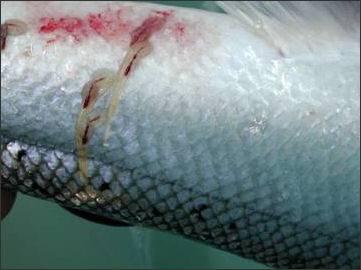
Sea lice on salmon Joel K. Bourne, Jr. Wrote in National Geographic: “The modern salmon industry has plunked densely packed net pens full of Atlantic salmon into pristine fjords from Norway to Patagonia, has been plagued by parasites, pollution, and disease. Scottish salmon farms lost nearly 10 percent of their fish in 2012 to amoebic gill disease; in Chile infectious anemia has killed an estimated two billion dollars’ worth of salmon since 2007. [Source: Joel K. Bourne, Jr., National Geographic, June 2014]
People opposed to fish farming include traditional fishermen, environmentalists, and coastal dwellers. Some conservationists complain that it takes 2.5 to 4 pounds of fish (usually ground up sardines, anchovies, mackerel or herring) made into pellets to produce one pound of salmon. This means, environmentalists argue, that salmon farming contributes to rather than helps the overfishing problem. People in the salmon industry counter it takes less feed to produce a pound of salmon than a pound of pork, beef or chicken.
Salmon farms foul the sea around the pens and spread disease and lice to wild salmon. The lice thrive among the tightly packed fish in the pens. Wild salmon pick up the lice when they pass by the pens or come into contact with escaped farm salmon. The lice can kill by feeding on the salmon’s flesh. In places where fish farming is done, the number of wild salmon have declined at alarming rates and may of those that survive are covered by lice.
Fish farm pellets are high in dioxins that sometimes enter the food chain. The pellets and fecal waste from salmon farms have been blamed for causing algae blooms which suck oxygen from the water, creating “dead zones” that harm local marine ecosystems and the shellfish industry. Chemicals used to battle the sea lice have killed other small creatures that wild fish rely on for food. Diseases are sometimes passed from farmed salmon to wild fish. Health issues for both people and marine ecosystems have been raised about the pigments used to make the salmon meat pink.

Refrigerated storage According to a study published in Science farmed salmon contains significantly higher levels of dioxin than salmon caught in the wild. Salmon farmed in northern Europe have the highest levels followed by North America and Chile. The problems was blamed on the feed given the farmed salmon which concentrates the oceans pollutants. Some researchers felt the study raised unnecessary alarms, insisting the levels of dioxin detected were way too small to cause any harm. Studies have also shown that farmed salmon have relatively high levels of PBDEs, flame-retardant chemicals used is the manufacturing of furniture, computers and consumer goods.
Between 1 and 5 percent of farmed salmon in Norway are deformed, according to research by Grete Baeverfjrd of the Norwegian Institute of Aquaculture Research, with the problem being near zero at some farms and as high as 25 percent at others. Most of the deformities are curved spines associated with growing to fast for the fish’s skeleton. Possible reason include an imbalance of minerals in feed, polluted water, cramped pens or high water temperatures. Deformed fish can be sold for human consumption in fillets and fish paste
Escaped Fish from Salmon Farms
Stock salmon that escape from fish pens are threatening wild salmon by taking over the rivers where they spawn and interbreeding with wild stocks, producing offspring less equipped for survival in the open oceans. In Norway, stock salmon escape as the result of storms, poorly maintained pens or hungry seals that damage the pens.
On average between 200,000 and 650,000 farmed salmon escape every year from Norwegian farms. The figure is around 300,000 from Scottish farms. A storm in Norway in 1990 released about 4 million fish.
Ten to 35 percent of the salmon in Norwegian spawning grounds are farmed salmon. In some rivers the stock salmon outnumber wild salmon four to one. In Chile and Canada, escaped salmon are outcompeting local Pacific salmons and other wild fish for food and spreading diseases and lice to wild fish, them, causing declines in their numbers. In Alaska, salmon farming is banned to protect local wild populations of Pacific salmon.
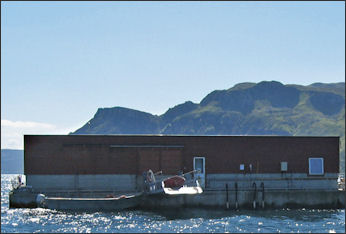
Portree Salmon Farm Farmed salmon are ill equipped to survive in wild. They are less able to defend themselves against predators than wild salmon. Their reproduction rates are low and they don’t have the genetic programming to help them migrate and adapt to specific rivers. Fish produced in hatcheries seem unable to return to the rivers in which their were leased. In the United States of the 9.5 million salmon fry released from one hatchery only 44 returned to spawn.
In 2007, 100,000 farmed salmon escaped from farms on the west coast of Scotland, causing a big stir there. In West Loch Roag, off the coast off Lewis, 20,000 maturing 2.5 kilogram fish escaped from their cage after a seal attack. In east Loch Talbery 18,500 fish escaped and 25,000 died as a result of equipment failure that caused a cage to sink. Near Lochportain on North Uist, 52,000 salmon made their way to freedom throw a hole in the net. Among the angriest people were those in the Scottish fishing, sport fishing and tourism industries that were worried about the sluggish farmed fish breeding with vigorous wild salmon just as they were heading up river to spawn. Many commercial fishermen and sport fishing operations rely on catching wild salmon.
Improvements at Salmon Farms
Pollution from coastal salmon farms gave all of aquaculture a bad name. By the mid 2010s salmon farms were producing 10 to 15 times the fish they did in the 1980s and 1990s with a fraction of the pollution. [Source: Joel K. Bourne, Jr., National Geographic, June 2014]
Improvements being made at salmon farms include leaving the pens empty periodically so wastes can be dispersed and inoculating fry in hatcheries rather than feeding adult fish antibiotics. Some farms have underwater video cameras to alert mangers when the fish have stopped feeding and the pellets are drifting to the bottom and to keep an eye out for seals.
Mussels and seaweed grown near salmon pens clean up the salmon waste and excess food is collected and used in the production of commercial crops. Salmon farmers in Norway were losing $1,500 a week to grey seal attacks but were reluctant to kill the seals. Instead they made a 16-foot-model of a killer whale — a “scarecrow” if you like — that for the short run anyway kept the seals away.
Environmentalists would like to see farmed salmon raised in walled tanks so the don’t escape, or better yet, in land tanks. Demand for fish is expected to double by 2040 and it is unlikely that fish farming will be halted. The key to maintaining the industry while be to figure out ways for it to thrive without damaging the environment.
Efforts to improve fish farming practices in the United States has lead producers to go elsewhere where the industry is not regulated.
Genetically Modified Salmon Heads to Markets
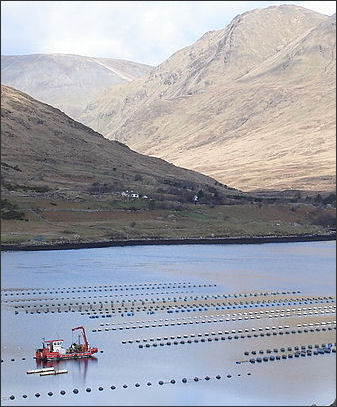
Salmon farm at Killary Harbour In May 2021, AquaBounty Technologies Inc. Began selling genetically modified salmon from the company's indoor aquaculture farm in Albany, Indiana. These are the first such altered animal to be cleared for human consumption in the United States. The fish are genetically engineered to grow twice as fast as wild salmon, reaching market size — 3.6 to 5.4 kilograms (8 to 12 pounds) — in 18 months rather than 36. [Source: Casey Smith, Associated Press, May 28, 2021]
AquaBounty has said that his company's fish product is safe and environmentally sustainable. Associated Press reports: AquaBounty markets the salmon as disease- and antibiotic-free, saying its product comes with a reduced carbon footprint and none of the risk of polluting marine ecosystems like traditional sea-cage farming carries. Despite their rapid growth, the genetically modified salmon require less food than most farmed Atlantic salmon, the company says. Biofiltration units keep water in the Indiana facility’s many 70,000-gallon (264,979-liter) tanks clean, making fish less likely to get sick or require antibiotics. Sylvia Wulf, President and CEO of AquaBounty, said she’s confident there’s an appetite for the fish. “Most of the salmon" in the U.S. "is imported,. So, having a domestic source of supply that isn’t seasonal like wild salmon and that is produced in a highly-controlled, bio-secure environment is increasingly important to consumers.”
Whether the public will have an appetite for GM salmon is still not known. Genetic engineering is already widely used for crops Although the potential benefits — and profits — are huge, many people have qualms about manipulating the genetic code of other living creatures. Genetically-engineered Coho salmon with a modified gene that allows them to grow at a faster pace, especially in the winter, can reach a weight up to 30 times greater than non-genetically-engineered salmon. Scientists are not sure what would happen if genetically-engineered salmon escaped into the wild. [Source: Mary Clare Jalonick, Associated Press, September 20, 2010]
Genetically modified, or GM (Genetically engineered, or GE) animals are not clones, which the FDA had approved as safe to eat earlier. Clones are copies of an animal. With GM animals, the DNA has been altered to produce a desirable characteristic.In the case of the salmon, AquaBounty has added a growth hormone from a Chinook salmon that allows the fish to produce their growth hormone all year long. The engineers were able to keep the hormone active by using another gene from an eel-like fish called an ocean pout that acts like an on switch for the hormone, according to the company. Conventional salmon produce the growth hormone only some of the time.
Critics of Genetically-Engineered Salmon
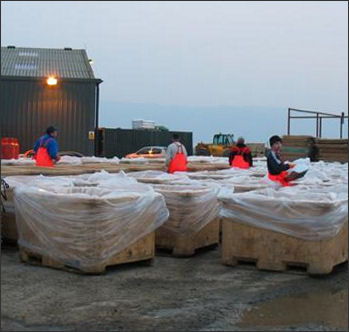
Fish Farm harvesting plant Critics have called genetically-modified salmon a "frankenfish" that could cause allergies in humans and the eventual decimation of the wild salmon population. The fish has been met by pushback from environmental advocates for years and the food industry has listened to them . In January 2021, The international food service company Aramark said it would not sell such salmon, citing environmental concerns and potential impacts on Indigenous communities that harvest wild salmon. Other major food service companies — Compass Group and Sodexo — and many large U.S. grocery retailers, seafood companies and restaurants issued similar announcements. Costco, Kroger, Walmart and Whole Foods maintain that they don’t sell genetically modified or cloned salmon and would need to label them as such. [Source: Casey Smith, Associated Press, May 28, 2021]
According to Associated Press: The boycott against AquaBounty salmon has largely come from activists with the Block Corporate Salmon campaign, which aims to protect wild salmon and preserve Indigenous rights to practice sustainable fishing. “Genetically engineered salmon is a huge threat to any vision of a healthy food system. People need ways to connect with the food they’re eating, so they know where it’s coming from,” said Jon Russell, a member of the campaign and a food justice organizer with Northwest Atlantic Marine Alliance. “These fish are so new — and there’s such a loud group of people who oppose it. That’s a huge red flag to consumers.”
Mary Clare Jalonick of Associated Press wrote: Critics have two main concerns: The safety of the food to humans and the salmon's effect on the environment. Because the altered fish has never been eaten before, they say, it could include dangerous allergens, especially because seafood is highly allergenic. They also worry that the fish will escape and intermingle with the wild salmon population, which is already endangered.They would grow fast and consume more food to the detriment of the conventional wild salmon, the critics fear. The FDA tried to allay both of those concerns, saying the fish shouldn't cause any allergies not already found in conventional salmon and that there is little chance they could escape. [Source: Mary Clare Jalonick, Associated Press, September 20, 2010]
European nations have been much more cautious in embracing engineered foods. Ruediger Rosenthal, a spokesman for Bund-Friends of the Earth Germany, said it is unlikely the modified fish would make it across the Atlantic for sale as many Europeans are very skeptical of genetically modified foods.
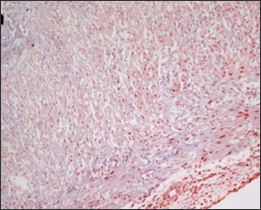
salmon disease AquaBounty has countered saying its products have come under more scrutiny than most food. "This is perhaps the most studied fish in history," former Aquabounty CEO Dr. Ron Stotish said. "Environmentally this is a very sustainable technology." The company has several safeguards in place to quell concerns. Aquabounty says its fish are monitored 24 hours a day and contained in tanks with screens, grates, netting, pumps and chemical disinfection to prevent escape. The company’s salmon are also female and sterile, preventing them from mating though a small percentage might be able to breed. They would be bred in confined pools where the potential for escape would be low. “Our fish are actually designed to thrive in the land-based environment. That’s part of what makes them unique,” Wulf said. “And we’re proud of the fact that genetically engineered allows us to bring more of a healthy nutritious product to market in a safe, secure and sustainable way.”
Stotish said the fish would be bred in better conditions than many of the world's farmed salmon and could be located closer to towns and cities to help feed more people. The company has also said the increase in engineered salmon production could help relieve endangered wild salmon populations.
FDA Approval of Genetically Modified Salmon
The FDA approved the AquAdvantage Salmon as “safe and effective” in 2015. Associated Press reported. It was the only genetically modified animal approved for human consumption until federal regulators approved a genetically modified pig for food and medical products in December. In 2018, the federal agency greenlit AquaBounty’s sprawling Indiana facility, which is currently raising roughly 450 tons (408 metric tons) of salmon from eggs imported from Canada but is capable of raising more than twice that amount. [Source: Casey Smith, Associated Press, May 28, 2021]
AquaBounty submitted its first application for FDA approval in 1995, but the agency did not decide until 2008 to consider applications for genetically engineered animals — a move seen as a breakthrough by the biotechnology industry. In documents released ahead of a 2010 hearing, the FDA said there were no biologically relevant differences between the engineered salmon and conventional salmon, and there is a reasonable certainty of no harm from its consumption.
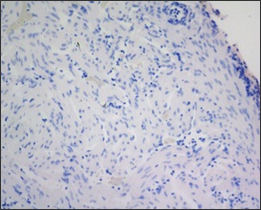
salmon disease One of the biggest issues with GM salmon is labeling. According to Associated Press: Salmon fishermen, fish farmers, wholesalers and other stakeholders want clear labeling practices to ensure that customers know they’re purchasing an engineered product. USDA labeling law directs companies to disclose genetically-modified ingredients in food through use of a QR code, an on-package display of text or a designated symbol. Mandatory compliance with that regulation took full effect in January 2022, but the rules don’t apply to restaurants or food services. Wulf said the company is committed to using “genetically engineered” labeling when its fish are sold in grocery stores. Before the company said that the fish do not need to be labeled because "The label could even be misleading because it implies a difference that doesn't exist."
In November 2020, U.S. District Judge Vince Chhabria in San Francisco affirmed that the FDA had the authority to oversee genetically engineered animals and fish. But he ruled that the agency hadn’t adequately assessed the environmental consequences of AquaBounty salmon escaping into the wild.
Text Sources: Animal Diversity Web (ADW) animaldiversity.org; National Oceanic and Atmospheric Administration (NOAA) noaa.gov; Wikipedia, National Geographic, Live Science, BBC, Smithsonian, New York Times, Washington Post, Los Angeles Times, The New Yorker, Reuters, Associated Press, Yomiuri Shimbun, The Guardian, Lonely Planet Guides and various books and other publications.
Last Updated April 2023
